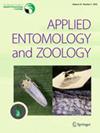Uncultivable and cultivable gut symbiotic bacteria of the jewel stinkbug Scutellera amethystina (Hemiptera: Scutelleridae)
Abstract
Many plant-sucking stinkbugs develop a symbiotic organ in a posterior region of the midgut, wherein specific symbiotic bacteria exist and contribute to survival and reproduction of their hosts. The symbiotic bacteria range from uncultivable ones that have lost the capability of proliferation without their hosts to cultivable ones that retain the ability to proliferate not only within their hosts but also in the external environment. Such diverse host–symbiont relationships seem to represent different evolutionary stages from free-living through facultative symbiosis to obligatory mutualism. However, our understanding of such evolutionary processes toward symbiosis is still limited. Here we investigated the gut symbiotic bacteria of the invasive jewel stinkbugs Scutellera amethystina (Germar) (Hemiptera: Scutelleridae) collected from different subtropical island populations in Japan. While most insects were associated with a specific Pantoea-allied uncultivable bacterial symbiont in the midgut symbiotic organ, we found an insect associated with a phylogenetically distinct Pantoea symbiont, which was cultivable and closely related to cultivable gut symbiotic bacteria previously reported from other stinkbug species. These results uncover intraspecific coexistence of uncultivable and cultivable gut symbiotic bacteria in S. amethystina, which provides insights into the evolutionary processes toward obligatory mutualism and symbiont uncultivability.


 求助内容:
求助内容: 应助结果提醒方式:
应助结果提醒方式:


